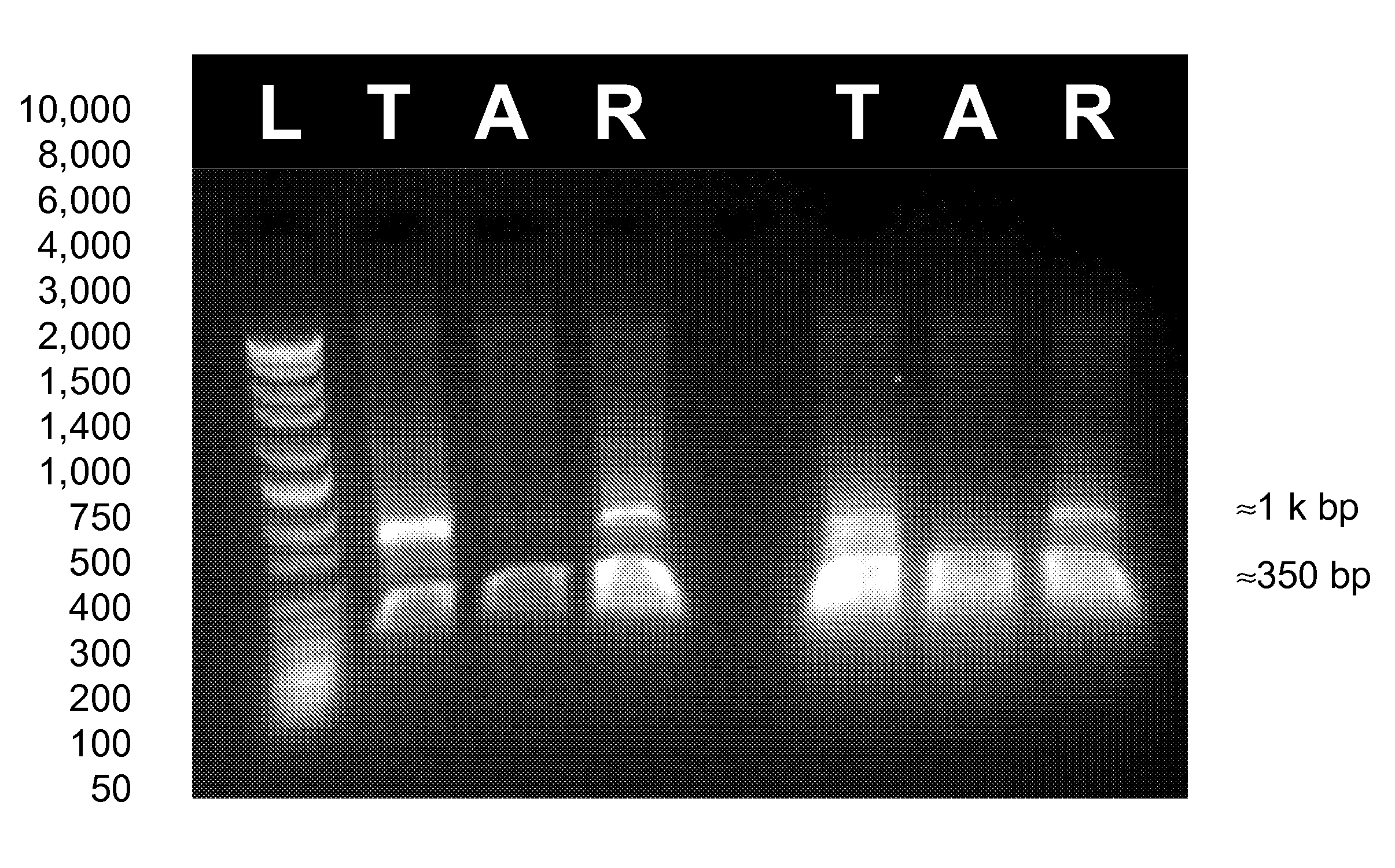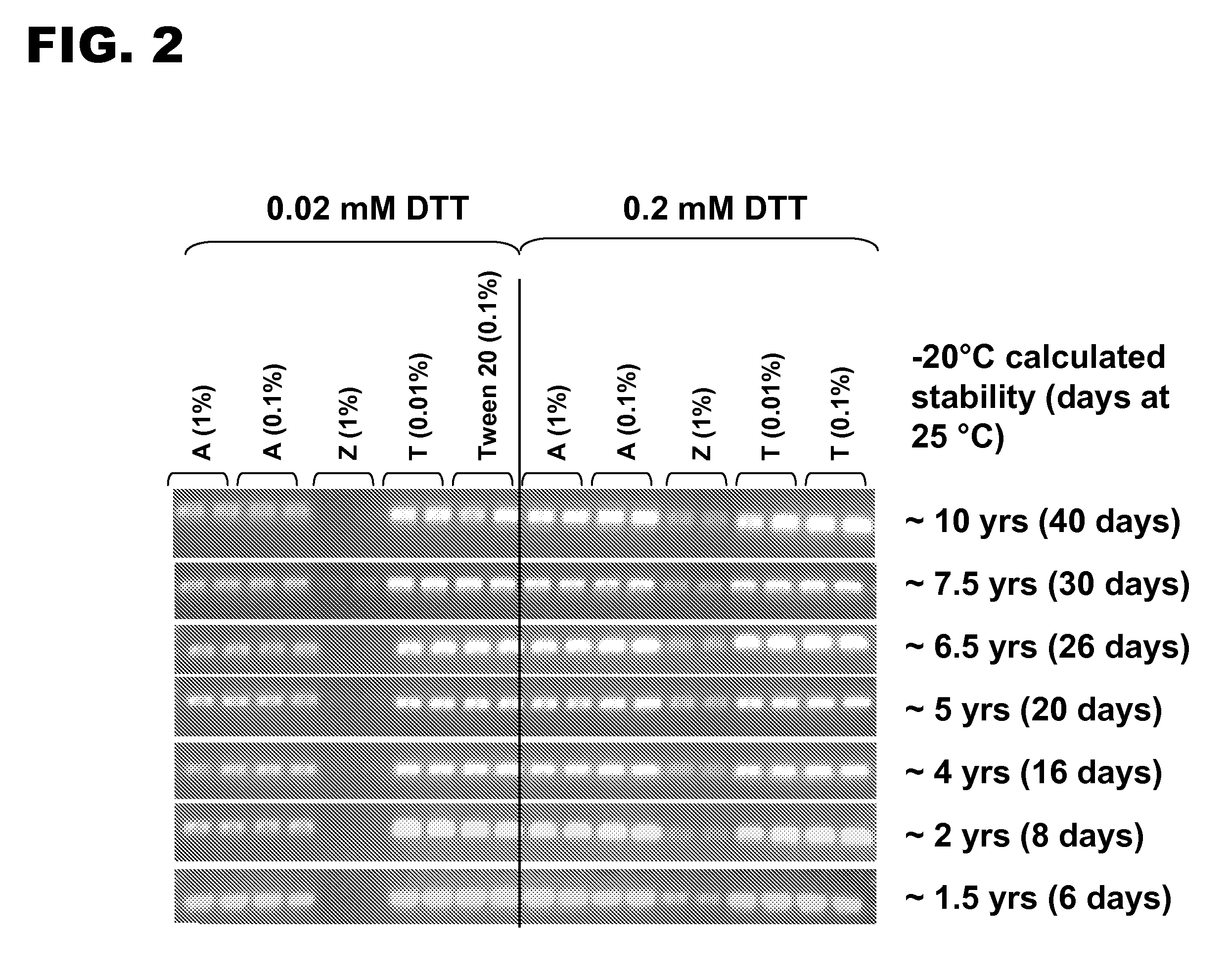Stabilized compositions of thermostable DNA polymerase and anionic or zwitterionic detergent
a technology of anionic or zwitterionic detergent and thermostable dna, which is applied in the direction of enzyme stabilisation, enzymology, transferases, etc., can solve the problems of non-specific product amplification, prone to inactivity, and amplification efficiency
- Summary
- Abstract
- Description
- Claims
- Application Information
AI Technical Summary
Benefits of technology
Problems solved by technology
Method used
Image
Examples
example 1
Detergent Screening
[0098]A PCR assay was used to screen 47 of the potential candidate detergents for their ability to stabilize Taq DNA polymerase. The final concentration of each detergent tested was 5%, 0.5%, 0.05%, 0.005%, or 0.0005%. A forward primer (5′-TGGATACCCGTCGTGGCTCTAATT-3′; SEQ ID No:1) and a reverse primer (5′-CTTCTTTCGTCCCCGTCAGGCTGA-3′; SEQ ID No:2) were designed to amplify a 500 bp fragment of lambda DNA. Each 10 μl reaction contained:
[0099]1 μl 10×PCR Buffer
[0100]0.2 μl 10 mM dNTPs
[0101]1 μl 10 μM Forward Primer
[0102]1 μl 10 μM Reverse Primer
[0103]1 μl ˜5 ng / μl lambda DNA
[0104]1 μl 10× detergent (50%, 5%, 0.5%, 0.05%, 0.005%)
[0105]4.7 μl dH2O
[0106]0.1 μl 5 Units / μl Taq DNA polymerase
[0107]The cycling parameters were 94° C. for 15 min and 30 cycles of 94° C. for 30 sec and 70° C. for 30 sec, and a 4° C. hold. For each series of detergents tested, positive control reactions comprising 0.0005% Tween 20 were included, as well as negative control reactions without any d...
example 2
Stabilization of Taq Formulations with DTT
[0109]The long-term stability of Taq formulated with either Tween 20, an anionic detergent, or a zwitterionic detergent was compared in the presence of two concentrations of DTT. Taq was formulated with 0.01% or 0.1% Tween 20, 0.1% or 1% poly(ethylene glycol) 4-nonylphenyl 3 sulfopropyl ether potassium salt, or 1% CHAPS. Each formulation was stored in the presence of 0.02 mM DTT or 0.2 mM DTT at 25° C. for periods of time ranging from 6 days to 40 days. The calculated corresponding periods for storage at −20° C. ranged from about 1.5 years to about 10 years (see FIG. 2). The ability of various formulations of Taq to support PCR was assessed using a PCR assay similar to that described in Example 1. The same primers and reactions conditions were used.
[0110]An aliquot of each reaction was resolved by agarose gel electrophoresis. Representative gel images are shown in FIG. 2. The Tween 20 formulations were essentially unaffected by storage time ...
example 3
Amplification Efficiency with Tween 20 or Anionic Detergent Formulated Preparations
[0111]The efficiency of amplification by Taq DNA polymerase in the presence of Tween 20 or the anionic detergent, poly (ethylene glycol) 4-nonylphenyl 3 sulfopropyl ether potassium salt, was compared using SYBR Green quantitative real-time PCR (qPCR) to amplify four different fragments in Msel-digested or intact human genomic DNA. Primers used to amplify 14-3-3, CD14F, HOXA2, and PGK1 are presented in Table 1. Each reaction comprised 1× Jumpstart Taq Ready mix (Sigma Aldrich, St. Louis, Mo.) formulated with Tween 20 or poly (ethylene glycol) 4-nonylphenyl 3 sulfopropyl ether potassium salt, 1×ROX (reference dye), 0.8×SYBR green, 0.4 μM primers. The template was serially diluted such that reactions contained 25 ng, 2.5 ng, or 0.25 ng of intact DNA or 400 ng, 40 ng, of 4 ng of digested DNA. The cycling profile was 95° C. for 3 min, 35 cycles of 95° C. for 30 sec, 55° C. for 60 sec, and 72° C. for 120 se...
PUM
| Property | Measurement | Unit |
|---|---|---|
| temperatures | aaaaa | aaaaa |
| temperatures | aaaaa | aaaaa |
| temperature | aaaaa | aaaaa |
Abstract
Description
Claims
Application Information
 Login to View More
Login to View More - R&D
- Intellectual Property
- Life Sciences
- Materials
- Tech Scout
- Unparalleled Data Quality
- Higher Quality Content
- 60% Fewer Hallucinations
Browse by: Latest US Patents, China's latest patents, Technical Efficacy Thesaurus, Application Domain, Technology Topic, Popular Technical Reports.
© 2025 PatSnap. All rights reserved.Legal|Privacy policy|Modern Slavery Act Transparency Statement|Sitemap|About US| Contact US: help@patsnap.com



